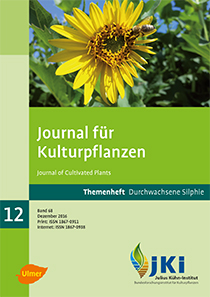Yield physiology of biogas crops: comparison of cup plant, maize, and lucerne-grass
Keywords:
Water uptake, water use efficiency, radiation use efficiency, biogas, energy crops, root characteristicsAbstract
An irrigation field experiment was conducted at Braunschweig to compare the yield performance as well as the water and radiation uptake and use efficiency of the biogas crops cup plant, maize and lucerne-grass. Additionally, at six other sites with varying soil conditions, root characteristics of maize and cup plant were studied. In Braunschweig, the cup plant dry matter yield of 13.5 t ha–1 averaged across years and water regimes was at the same level as that of lucerne-grass (13.2 t ha–1), but significantly lower than that of maize (19.7 t ha–1). Accordingly, the water use efficiency of cup plant was similar to that of lucerne-grass but significantly lower than that of maize. With a share of at best 0.3% of the total water consumption the condensation water trapped in the leaf cups was not relevant for cup plant yield. The adverse effect of drought on the specific methane yield (–6%) was not as strongly as expected. While the lower maize leaves remained photosynthetically active until harvest, the comparatively high leaf area index of cup plant caused the lower leaves to die prematurely due to lack of light. With up to 2.7 m on deep loess, the cup plant rooted deeper than the maize. Even if not all expectations have been fulfilled (e.g. drought tolerance and biomass yields comparable with maize), permanent cup plant crops increase the agro-biodiversity and contribute by the supply of large quantities of organic matter as well as the long-term greening to soil and water protection.
DOI: 10.1399/JfK.2016.12.06, https://doi.org/10.1399/JfK.2016.12.06








